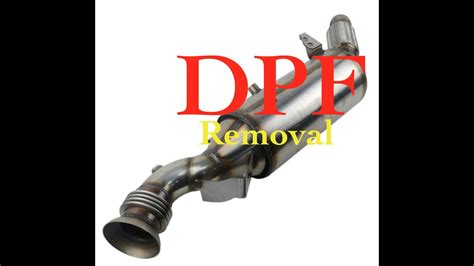Sprinter DPF Delete: Pipe Cutting – A Step-by-Step Video Guide (and Much More!)
Removing a Diesel Particulate Filter (DPF) from a Mercedes-Benz Sprinter van is a significant modification with potential legal and environmental consequences. This article aims to provide comprehensive information about the process, focusing on the pipe cutting aspect often highlighted in videos. Crucially, we strongly advise against performing this modification yourself unless you are a qualified mechanic with the appropriate tools and expertise. Modifying your emissions system can result in hefty fines and invalidate your vehicle's warranty. This information is for educational purposes only.
This article addresses the common concerns and questions surrounding Sprinter DPF deletes, including the pipe cutting procedure. We'll delve into the technical aspects, potential risks, and legal ramifications.
What is a DPF Delete?
A DPF delete involves physically removing the DPF from the exhaust system and often replacing it with a straight pipe or a modified exhaust system. This bypasses the DPF's function of filtering particulate matter from diesel exhaust fumes.
Why Do People Delete Their DPFs?
Several reasons motivate DPF removal:
- Clogged DPF: A clogged DPF can severely restrict exhaust flow, leading to reduced engine performance, increased fuel consumption, and even engine damage. Regeneration attempts might not always succeed.
- Cost of Replacement: Replacing a DPF can be very expensive.
- Misconception of Performance Gains: Some believe a DPF delete improves engine performance, though this is often negligible and outweighed by the negative consequences.
Sprinter DPF Delete: The Pipe Cutting Process (As Seen in Videos)
Many online videos demonstrate the pipe cutting process as part of a DPF delete. This usually involves:
- Accessing the DPF: This requires accessing the underside of the vehicle and potentially removing parts of the exhaust system.
- Cutting the Pipes: Specific sections of the exhaust pipe are cut using a cutting wheel, angle grinder, or similar tools. Precision is crucial to ensure a proper fit for the replacement pipe.
- Welding or Clamping: Once the DPF is removed, the cut ends of the pipes are usually joined using welding or specialized exhaust clamps.
- Testing: After reassembly, the system needs to be thoroughly tested for leaks and proper functionality.
H2: What are the legal implications of a DPF delete?
Modifying your vehicle's emissions system to bypass the DPF is illegal in many jurisdictions. This can result in significant fines, vehicle impounding, and even criminal charges. Regulations vary by location, so it's crucial to research your local laws before considering a DPF delete.
H2: Are there alternatives to a DPF delete?
Yes, there are alternatives to a DPF delete that can address the problems associated with a clogged DPF:
- DPF Cleaning: Professional cleaning services can often restore a clogged DPF to its original functionality, providing a more cost-effective solution than replacement.
- DPF Replacement: While expensive, replacing a faulty DPF is the most environmentally responsible option and ensures compliance with emissions regulations.
- Exhaust System Modification (Without DPF Removal): Certain modifications can improve exhaust flow without removing the DPF, potentially mitigating some of the issues associated with a clogged filter.
H2: What tools are typically used in a DPF delete?
Videos often show the use of specialized tools such as:
- Jacks and Stands: For safe vehicle access.
- Cutting Wheels/Grinders: For precise pipe cutting.
- Welding Equipment (or Clamps): For joining the exhaust pipes.
- Wrenches and Sockets: For removing and installing exhaust components.
- Protective Gear: Essential for safety during the procedure.
H2: How can I find a reputable mechanic for DPF work?
If you need DPF work done, seek out a certified and reputable mechanic experienced with diesel vehicles and emission systems. Check online reviews and ensure they are licensed and insured.
Disclaimer: This article provides general information. The specifics of a DPF delete, pipe cutting, and related procedures vary greatly depending on the vehicle's make, model, and year. We strongly reiterate the advice to avoid performing this modification yourself unless you are a highly qualified mechanic. Always comply with all relevant laws and regulations regarding vehicle emissions.

